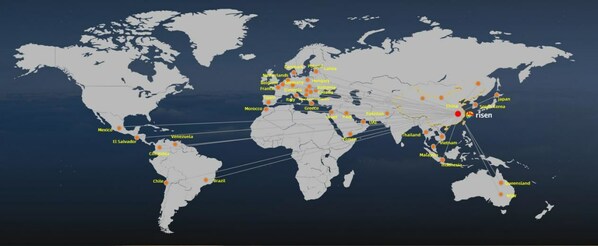NINGBO, China, March 22, 2024 /PRNewswire/ — Since its official launch in July 2023, Risen Energy’s 700Wp+ heterojunction (HJT) Hyper-ion modules have been demonstrating strength in overseas markets. With continuous improvements in module power and efficiency, as well as outstanding performance in high power generation and low carbon footprint, they are highly favored by customers worldwide. As of now, Hyper-ion modules have been exported to nearly 40 countries and regions globally, with a cumulative shipment volume exceeding 3GW. Meanwhile, Risen Energy has been actively involved in the Belt and Road Initiative, with its Hyper-ion modules not only catching on mature photovoltaic (PV) markets in Europe and Latin America but also expanding to countries along the Belt and Road, including the United Arab Emirates, Pakistan, Israel, Iraq, Indonesia, Yemen, and etc. Risen Energy has been contributing its share to the global green economy while further boosting its brand influence.
Innovation is the core drive behind the steady development of Risen Energy. Throughout the R&D of HJT products, Risen Energy innovatively established an integrated R&D model for the HJT technology from silicon materials to modules, becoming the first enterprise in the industry to mass-produce HJT products with zero Busbar, ultra-thin silicon wafers, silver consumption of less than 7mg/W, and stress-free Hyper-Link interconnection technology, which effectively facilitates the mass production of its HJT Hyper-ion products. Currently, the average efficiency of Risen Energy’s HJT Hyper-ion solar cells in mass production exceeds 25.8%, with the module power surpassing 715Wp. With the continuous optimization of the HJT Hyper-ion solar cell production process and breakthroughs in technology, both the conversion efficiency and module power continue to steadily increase.
As the global consensus on carbon reduction continues to expand, there is a significant increase in demand for renewable energy technologies and products. Against this backdrop, products that reduce LCOE and have a lower carbon footprint are driving the future advancement of the solar industry. HJT, as the technology and product with the highest conversion efficiency and electricity generation in single-junction technologies, also possesses unique low carbon footprint attributes, making it more suitable for the market’s technological path of low LCOE and low carbon demand. Moreover, the HJT cell structure is more easily to form tandem cells with perovskite, with excellent potential for technological iteration and broad development prospects.
Going forward, Risen Energy will continue to carry out technological upgrades and iterations in the field of HJT, reducing costs and increasing efficiency to solidify its core competitiveness, leading the industry in leapfrog upgrades, and empowering global customers to accelerate green sustainable development.
View original content to download multimedia: Read More


